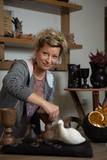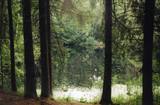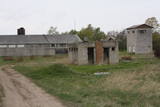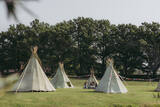| Nr | Name | Beschreibung |
|---|---|---|
|
Prepared blood sausages both traditional and more modern. The farms offer sausage-making demonstrations for various interest groups. Farm sausages are special with the prize won at the Riga Food exhibition - People's Taste. Open at any time by prior arrangement. |
||
|
Aus dem Wacholder, der als Symbol der Insel Saaremaa gilt, wird auch ein wertvoller Sirup hergestellt. Die Gäste werden vieles über Wacholder erfahren. Von Frühling bis Herbst kann man die Pracht des Gartens genießen und das alte Bauernhaus besichtigen. |
||
|
Der Apfelweinbetrieb Tori befindet sich auf dem authentischen Bauernhof Soomaa, wo Apfelbäume und Weinstock angebaut und aus der eingebrachten Ernte Wein und Apfelwein hergestellt werden. Im Betrieb werden die Gäste in die Geheimnisse des guten Apfelweins und Weins sowie Besonderheiten des Weinbaus im Norden eingeweiht. Außerdem wird Essen angeboten und werden Verkostungen veranstaltet. |
||
|
Innovative und köstliche Hanf- und Buchweizenprodukte, die sowohl lecker sind als auch dem Bauch gut tun. |
||
|
Guest house "Aivari" is located in a quiet forest in Inčukalns region. Offers rest in a country sauna, after the sauna it is possible to use a shower, cool off in the pool, also a swim in the spring pond and a wooden tub. There are tent sites, a picnic area with awnings, a volleyball net and several campfire sites. |
||
|
This is one of the few craftswomen in Latvia who does not use a potter’s wheel in her work. Instead she works in the “snail” or “sausage” technique that was typical of the Bronze Age. Her artworks are distinguished by a diversity of form and functionality. Children can attend master’s classes. You can take tours, take part in the opening of the kiln, and purchase fumigated ceramics products. |
||
|
Der „Hof der lauten Stille“ befindet sich am Hang zum Ufer eines Altarms des Nevėžys. Hier werden „glückliche Nahrungsmittel“ hergestellt, ausschließlich aus dem, was auf dem eigenen Hof erzeugt wird. |
||
|
Ap 6 km garā pussala ir vieta, kur jānokļūst tiem, kas grasās doties vienā no neparastākajiem pārgājieniem pāri jūras šaurumam. Cauri Kūsnemmes pussalai līdz tās ziemeļu daļai iet šaurs un ļoti līkumains grants ceļš (ar garāku tūristu autobusu jābrauc lēni un uzmanīgi), kura galā izveidots autostāvlaukums, neliels namiņš, kur patverties lietus un vēja laikā, kā arī informācijas stends. Turpat redzamas divas Padomju armijas „KRAZ” tipa automašīnas. Lai sasniegtu robežkontroles posteni, Padomju robežsargi brauca pa jūru un mazajām saliņām, kas kā pērļu virtene savieno Kūsnemmes pussalas galu ar Vilsandi salas dienviddaļu. Turpat divas desmitgades pēc Igaunijas neatkarības atjaunošanas „KRAZ” automašīnu kravas kastēs vasaras laikā uz Vilsandi vizināja tūristus, taču spēkrati savu mūžu ir nokalpojuši un unikālais piedāvājums vairs nav spēkā! Ko darīt? Pa mazajām saliņām uz Vilsandi var doties ar kājām. To var īstenot tikai siltā laikā, kad nav gaidāms stiprs vējš un ir zināma laika prognoze vismaz divām tuvākajām dienām. Kā sava veida orientieris var kalpot augstsprieguma elektrolīnija. Kopumā ir jārēķinās arī ar 1 h 40 – 2 h ilgu un ~ 4 km garu gājienu. Dziļākā vieta (ja ietur pareizo „kursu”) atrodas pārgājiena sākumdaļā, kur starp saliņām izveidots laivu ceļš - ~ 1 m dziļa vieta atkarībā no vēja virziena un ūdens līmeņa. Zināmu priekšstatu par maršrutu sniegs redzamā ainava, kas paveras no skatu torņa. Kaut arī šis maršruts tiek reklamēts dažādos informatīvajos materiālos, atbildību par tā veikšanu uzņemas katrs pats! |
||
|
Diese Tour gibt Ihnen einen Eindruck vom östlichen Teil Lettlands, der weniger bevölkert und auch bei Touristen weniger beliebt ist. Sie werden zuerst in Aluksne ankommen und die Stadt erkunden, die sich im Hochland von Alūksne am Ufer des Alūksne-Sees befindet. Es lohnt sich, Temple Hill zu besuchen - einen alten lettischen Burghügel und den Ort der Altstadt, der Sonnenbrücke, des Schloss-Herrenhausparks, der Alūksne Lutheran Church und des Bibelmuseums. Nachdem Sie dort übernachtet haben, fahren Sie mit dem Bus zum Startpunkt der Wanderung in Ape. Dieser Waldwegabschnitt schlängelt sich durch eine hügelige Ackerlandschaft und mündet dann in einen großen dunklen Wald, der gelegentlich von den blauen Oberflächen der Seen unterbrochen wird. Nach Peļļi überquert es die lettisch-estnische Grenze und windet sich 2 km lang an den Ufern der Seen Smilšājs, Sūneklis und Ilgājs auf der estnischen Seite, bekannt als Paganamaa (Übersetzung: Teufelsland). Dort steigt es ab und tritt in die subglaziale Depression Korneti-Peļļi ein, eine der beeindruckendsten Schluchten Lettlands. Der Waldweg kehrt am Ilgājs-See nach Lettland zurück und führt Sie nach einem steilen Aufstieg durch ein hügeliges Gebiet zum Burghügel von Drusku. Hier können Sie eine schöne Aussicht genießen. Am Ende dieser Tour erreichen Sie Korneti. Der Abschnitt befindet sich im geschützten Landschaftsgebiet „Veclaicene“. |
||
|
In der Handarbeitsstube Lõnga Liisu kann man beobachten, wie früher Wolle gesponnen wurde und wie man heutzutage Stricksachen anfertigt. Erlernen Sie Wolle kardieren und spinnen und probieren Sie mal auf einem Webstuhl Teppiche zu weben. Im Geschäft gibt es viele nette Sachen zum einkaufen. In der Handarbeitsstube Lõnga Liisu werden auch grössere Gruppen empfangen. |
||
|
Ein anderes Gebiet mit Hinweisen auf wasserlöslichen Kalk in der Erde. Da der Kalk verschwindet, gibt es unterirdische leere Gebiete, die möglicherweise einbrechen. Im osten von Skaistkalne wurde ein Erholungsplatz eingerichtet, wo sich trockene und gefüllte Löcher verschiedener Größe befinden.
|
||
|
Die ehemalige Meldegängerabteilung in Pļavmalas wird zur Zeit als Lager für die Landwirtschftsprodukte genutzt. Das Objekt ist im Besitz von einem Bauernhof.
|
||
|
Ein biologischer Familienbetrieb in Võrumaa, im Naturpark Haanja (Haanja rahvuspark). Der Betrieb befasst sich mit der Ziegenzucht und Ziegenkäseproduktion. Hier werden Verkostungen und Führungen veranstaltet. Dabei kann man sehen, wie Milch aus dem Stall zu einem Käselaib wird. |
||
|
Bauernhof Maizes māja in der Nähe von Cēsis, wo man Genuss, Kraft und Lebenskunst erhalten kann! Es werden Piroggen-Partys und Brotback-Events; Vorstellung der Bäcker- und Kochberufe; Lebensfähigkeiten und Naturabenteuer; traditionelle und Jahresfeste; Feiern in der alten Kornkammer organisiert. Schüler, Familien, Freunde und Touristengruppen werden in „Maizes māja“ für eine Weile zu Mitgliedern des Haushalts: Dabei haben sie viel zu tun – das Brennholz muss getragen, der Ofen geheizt werden und in einem echten Brotofen wird Roggenbrot oder süß–saures Brot aus Kaupo–Roggenmehl gebacken |
||
|
Glamping "Kadiķi" is located in Auce region - it will open in July 2021. It is a unique recreation area with a private area where you can find new feelings, spend the night in wigwam, merge with nature, enjoy the peace and quiet far from the city, see flocks of deer and deer, surround the surrounding waters, go hiking on forest trails, archery, enjoy the beauty of the natural landscape and gain an unforgettable rural adventure. The company's values are nature, private space and atmosphere, ecologically responsible attitude towards the environment. The wigwam has amenities worthy of a glamping tent - bed, interior items, outdoor terrace. Guests will also have breakfast. Nomadic Homes also offers to buy or rent wigwams for private events, recreation or starting your own business. |
||
|
Skuķu un netāli esošais Dvietes ezeri ir vieni no teritorijas grūti pieejamajiem palieņu ezeriem – lielākie šāda tipa
ezeri Latvijā. Palu laikā pārplūst, savienojoties vienā lielā ūdenskrātuvē.
|
||
|
Krodziņš "Mežavējš" atrodas Rīgas - Liepājas šosejas 101. kilometrā. Krodziņa ēdienkartē iekļauti latviskie ēdieni. Latviešu virtuve: Skābu kāpostu zupa, biešu zupa, skābeņu zupa, aukstā zupa, kartupeļu pankūkas, plānās pankūkas ar ievārījumu, šmorētas cūkgaļas ribiņas, zemnieku cienasts, mājas kotletes, auzu pārslu kārtojums, rupjmaizes kārtojums. |
||
|
Auf der Küste der Halbinsel befinden sich sowohl ehemalige Fischerdörfer, als auch die Reste eines Militärstützpunkts der Sowjetarmee. Großartige von den Gletschern des Eiszeitalters eingebrachte Feldsteine. |
||
|
Hier kann man die Geschichte und das Kulturerbe der Liven von Vidzeme kennenlernen, indem man die Sammlung des Museums besichtigt und die Gerichte und Getränke probiert, die früher dieser Region charakteristisch waren: Graupengrütze und das nach alten Rezepten gebraute, starke alkoholische Getränk Škaļika. Gruppen von Interessenten können hier in einem ländlichen Ofen Roggenbrot backen. Lettische Küche: Gerstengrütze mit gebratenen Fleischstücken und Zwiebeln und mit Marmelade oder Soße aus Moosbeeren oder Preiselbeeren, Kräutertee mit einem Moosbeerensirup, alkoholisches Getränk Škaļiks. |
||
|
In Veranstaltungen zum Thema erzählen die Landwirte von den Eigenheiten des Anbaus von Faserhanf und machen mit der Vielfalt der Produkte aus Hanf bekannt. Dabei werden die Besucher mit Hanfprodukten aus der eigenen Produktion bewirtet. |
||

























